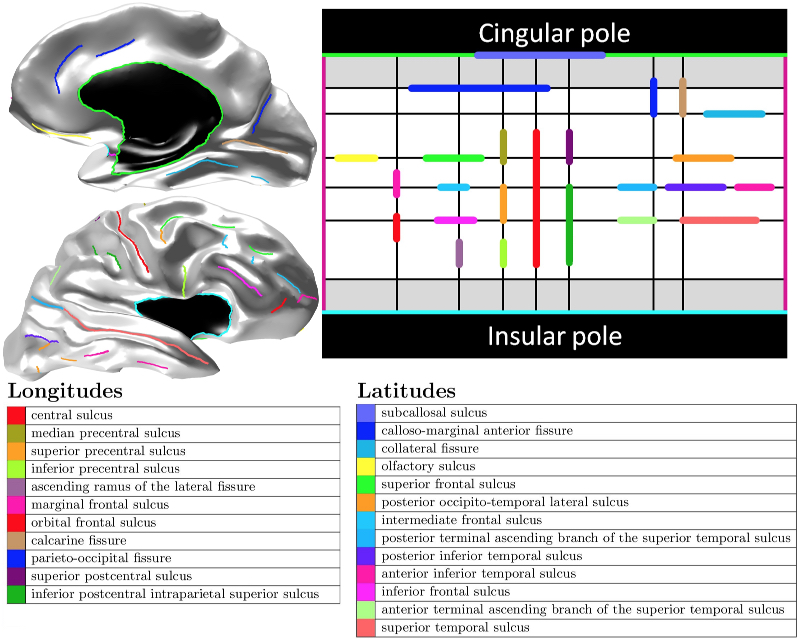Cortical surface parameterization and inter-subject matching
This process performs a parametrization of the white matter surface, and implicitely provides an inter-subject cortical surface matching. The resulting 2D coordinate system (longitude/latitude) is fitted to a model of cortical organization, which means that a number of sulcal lines have a constant coordinate (longitude or latitude) and that some pairs of sulci have the same coordinate because they are aligned in our model. For instance, the fundus of the central sulcus has a constant longitude value equal to 0, or the fundi of the superior temporal sulcus and the inferior frontal sulcus are aligned in the coordinate system with a constant latitude value of 106. Each hemisphere is parameterized independentely. Below is a schematic description of the model.

The parameterization is performed via a conformal mapping of each hemisphere surface to a rectangular domain, followed by a registration to the model in this domain. The processed is called HIP-HOP (Harmonic Intrinsic Parameterization – Harmonic Orthogonal Parametrization) as a reference to the two main steps of the process.
The latest version of the process is in the BrainVisa Cortical Surface Toolbox, under the Anatomy category and is called: Hip-Hop Cortical Parameterization. It has been described in the following publication:
Auzias G, Lefèvre J, Le Troter A, Fischer C, Perrot M, Régis J, Coulon O (2013). Model-driven Harmonic Parameterization of the Cortical Surface: HIP-HOP, IEEE Trans Med Imaging, 32(5):873-887.
Because each individual cortical surface parameterization is constrained by the same model, HIP-HOP implicitely provides a inter-subject matching. We also provide the tools to explicitely use this matching.
This process has been used (at least) in the following publications:
Rabiei H, Richard F, Roth M, Anton J-L, Coulon O, and Lefèvre J (2015). Local Spectral Analysis of the Cerebral Cortex: New Gyrification Indices, IEEE Transactions on Medical Imaging, https://doi.org/10.1109/TMI.2016.2633393.
Auzias G, De Guio F, Pepe A, Rousseau F, Mangin J-F, Girard N, Lefèvre J, Coulon O (2015). Model-driven parametrization of fetal cortical surfaces, 12th IEEE International Symposium on Biomedical Imaging, Brooklin, USA.
Auzias G, Lefèvre J, Le Troter A, Fischer C, Perrot M, Régis J, Coulon O (2013). Model-driven Harmonic Parameterization of the Cortical Surface: HIP-HOP, IEEE Trans Med Imaging, 32(5):873-887.
Below is a short tutorial to run this process
Starting from a T1 image we recommend the following pipeline. In a nutshell, images need to be segmented, then cortical (white matter) surfaces reconstructed, then sulci extracted and identified, before the HIP-HOP pipeline can be ran.
Segmentation can be performed using FreeSurfer, or directly using the Morpholgist pipeline of BrainVisa. Surface reconstruction and sulal extraction and reconstruction must be performed using the Morphologist pipeline.
We recommend to use the FreeSurfer segmentation. The reason is that it provides a more convenient inter-hemispheric segmentation by filling the ventricules. Until that issue is fixed with BrainVisa it provides a more suitable surface. Nevertheless it is possible to use BrainVisa all the way and we have done it many times..
For data management and general use of BrainVisa, see the documentation
Step-by-step:
- it is recommended but not mandatory that T1 images are preprocessed using the Non Local Means denoising algorithm, which greatly helps the segmentation process. NLM algorithm can be found for instance in the SPM VBM toolbox.
- Once images are denoised (or not) they must be imported in a BV database using the Morphologist -> Import T1 image process.
- For the Freesurfer segmentation
- you must have a FreeSurfer database created in BrainVisa. This is done by adding a database in the preferences and making sure it is declared as a Freesurfer database.
- you must also tell BrainVisa where is your freesurfer installation. You can do that in the general preferences.
- run the Freesurfer -> Freesurfer / BrainVisa full pipeline process.
- import your processed subjects using the FreeSurfer -> import -> Import From Freesurfer to T1 pipeline process. This will do the import and -run the Morphologist pipeline.
- For BrainVisa segmentation:
- run the Morphologist Pipeline on the imported T1 image, including sulcus labelling. The recommended method for automatic labelling is ‘SPAM, Global + Local’.
- Hip Hop pipeline: run the Cortical Surface -> Anatomy -> Hip Hop Cortical parameterization process.
- The pipeline produces a number of data, amongst which the MarsAtlas parcellation model, and coordinate files that can be used to perform inter-subject matching and group analysis (see below).
Inter-subject matching and group analysis:
- for inter-subject matching you will have to resample either the cortical surface meshes or/and textures that represent data defined on the cortical surface (e.g. functional or cortical thickness) .
UNDER CONSTRUCTION
